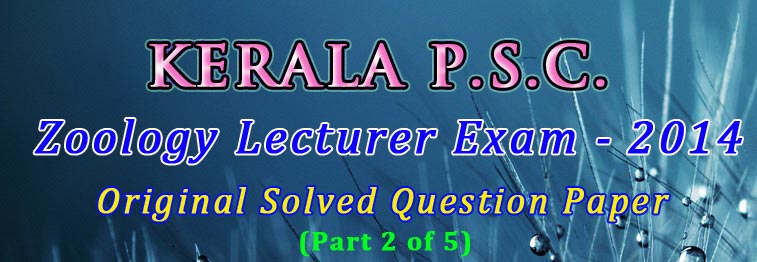
Kerala PSC Zoology Lecturer / Assistant Professor Recruitment Exam 2014
Question Paper (Q. Code 56/2014)
Original solved question paper of Kerala PSC Zoology Lecturer/Assistant Professor examination conducted by Kerala PSC (Kerala Public Service Commission) on 29/04/2014 (Question Paper Code 56/2014) for the appointment of Zoology Lecturer/Assistant Professor in Government Colleges of Kerala under the Directorate of Collegiate Education, Trivandrum, Kerala. Questions are in MCQ (Multiple Choice Questions) format.
Part – 2 of 5 (Questions 21 – 40)
21. From the following, select the correct combination. The immunoglobulin class produced in a primary response to an antigen and the first immunoglobulin to be synthesized by the neonate are:
a. IgM, IgM
b. IgM, IgG
c. IgM, IgA
d. IgM, IgD
Ans. (a)
22. In Grave’s disease, auto-antibodies:
a. Bind to receptor for TSH
b. Its action mimic the normal action of TSH
c. Over stimulate the thyroid
d. All the above
Ans. (d)
23. Which of the following is correct with respect to the function of complement system?
a. Lysis
b. Opsonization
c. Clearance of immune complexes
d. All the above
Ans. (d)
24. Haptens are:
a. Antigenic
b. Immunogenic
c. Both antigenic and immunogenic
d. Non-antigenic and non-immunogenic
Ans. (a)
25. George Kohler and Cesar Milstein are associated with:
a. Transplantation
b. Hybridoma technology
c. Vaccine development
d. Complement system
Ans. (b)
26. If E.coli is grown in a minimal medium containing glucose and lactose:
a. It use glucose first
b. It use lactose first
c. It use both glucose and lactose together
d. All are correct
Ans. (a)
27. Which of the following is correct:
a. Gram positive bacteria can have peptidoglycan up to 10% of cell wall
b. Gram negative bacteria can have peptidoglycan up to 90% of the cell wall
c. Gram positive bacteria can have peptidoglycan up to 90% of cell wall
d. Both gram positive and negative bacteria can have peptidoglycan up to 50% of cell wall
Ans. (c)
Learn more: Difference between Gram Positive and Gram Negative Bacteria
28. Lysozyme sensitive bond is:
a. β(1, 1) glycosidic bond present in peptidoglycan
b. β(1, 2) glycosidic bond present in peptidoglycan
c. β(1, 3) glycosidic bond present in peptidoglycan
d. β(1, 4) glycosidic bond present in peptidoglycan
Ans. (d)
29. Lipopolysaccharide is characteristic feature of:
a. Gram positive bacteria
b. Gram negative bacteria
c. Both (a) and (b)
d. None of the above
Ans. (b)
30. Dipicolinic acid is associated with:
a. Bacterial cell
b. Bacterial flagella
c. Bacterial surface
d. Bacterial spore
Ans. (d)
31. The first eukaryotic organism whose complete DNA is sequenced:
a. Chlamydomonas
b. Saccharomyces cervisiae
c. Pseudomonas
d. Caenorhabditis elegans
Ans. (b)
32. The first amino acid synthesized during protein synthesis:
a. Tyrosine
b. Proline
c. Methionine
d. Tryptophan
Ans. (c)
33. The heat stable DNA polymerase used in Polymerase Chain Reaction:
a. T7 DNA Polymerase
b. Thermo Polymerase
c. Taq DNA polymerase
d. Poly (A) Polymerase
Ans. (c)
34. The insert capacity of plasmid vectors:
a. 0.1 – 10 kb
b. 10 – 20
c. 34 – 45 kb
d. 80 – 100 kb
Ans. (a)
35. The blotting technique used to detect RNA
a. Western blot
b. Southern blot
c. Northern blot
d. Eastern Blot
Ans. (c)
36. A molecular marker utilizing restriction enzymes:
a. RAPD
b. AFLP
c. Micro satellite
d. RFLP
Ans. (d)
37. Which one is not a DNA staining reagent aiding DNA visualization:
a. Ethidium bromide
b. Sybr Green
c. Hoechst stain
d. Methyl red
Ans. (d)
38. The theory behind si-RNA therapy:
a. Correction of gene mutation with an oligonucleotide
b. Blocking translation of mRNA from a mutant gene with an oligonucleotide
c. Providing needed protein synthesized by blood cells
d. Removal of toxic molecules
Ans. (b)
39. The enzyme that degrades double stranded DNA:
a. DNase I
b. Mung Bean nuclease
c. S1 nuclease
d. RHase H
Ans. (a)
40. Identify a recombinant vaccine:
a. MMR vaccine
b. BCG
c. Polio
d. Hepatitis B vaccine
Ans. (d)
Kerala PSC Zoology Lecturer 2014 Exam
| Part 1/5 | Part 2/5 | Part 3/5 | Part 4/5 | Part 5/5 |
